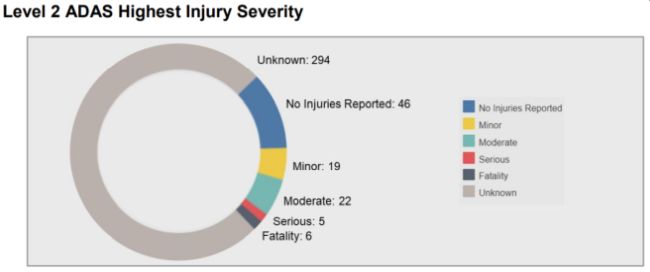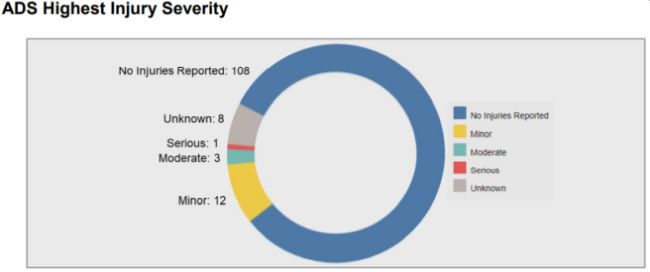Are autonomous vehicles safe? Are they safer than vehicles driven by people? Is one type of autonomous vehicle safer than another? Last week NHTSA released the data it gathered over the last year pursuant to last summer's Standing General Order requiring autonomous vehicle manufacturers and operators to report crashes in which autonomous driving systems were in use. NHTSA reported separately on data involving (a) advanced driver assistance systems ("ADAS," i.e. SAE Level 2) and (b) automated driving systems ("ADS," i.e. SAE levels 3-5). What's the upshot from NHTSA's data drop? Well, it's complicated.
Raw Data. NHTSA received reports of 392 crashes involving ADAS/Level 2-equipped vehicles and 130 crashes involving ADS/Level 3+ vehicles.
There were 11 crashes involving death or serious injuries among the ADAS/Level 2 data set. This equates to a 0.028 percent rate of death or serious injury in that cohort. It should be cautioned that the ADAS/Level 2 data included injury information for only 98 crashes. No injury information was provided for the remaining 75 percent of the data set. Query whether and to what extent this means there were no injuries or there simply was no injury data at the time of reporting for those 294 crashes.

The ADS/Level 3+ reporting included only one serious injury or death. The injury information was far more complete for the ADS data-less than 1 percent of reports lacked injury information. This cohort's serious injury/death rate equated to 0.008 percent. In total, 108 out of 130 ADS crashes resulted in no injuries.

Caveats Emptor. A number of caveats should be taken into consideration before making hard conclusions based on the data. First and probably most importantly, NHTSA admits that the "data are not normalized by the number of vehicles a manufacturer or developer has deployed or by vehicle miles traveled." The lack of information on miles travelled makes it impossible to conclude based on the data whether ADAS or ADS vehicles were more or less likely to be involved in crashes than manually driven vehicles. It's also not clear from the data whether the ADAS or ADS systems were faulted for the crashes or whether adverse drivers or conditions beyond the technology's control caused these crashes. And further it isn't known or knowable whether certain makes, models, or types of systems were involved in more or more severe crashes than others.
Second, the data come from different sources. Most of the data comes by way of vehicle telemetry, but a substantial portion comes from customer reporting. So any analysis of the data would not necessarily comparing apples to apples. And with respect to customer reporting, most ADAS/Level 2 vehicles are privately owned. Manufacturers may not know of crashes unless they are contacted by vehicle owners. For this reason, NHTSA cautions that the data "should not be assumed to be statistically representative of all crashes."
Third, in addition to coming from different sources, the incident reports contain different amounts of information. The reports vary from preliminary and incomplete to more comprehensive.
Fourth, ADAS and ADS vehicles still represent a small portion of vehicles on the road. ADS/Level 3+ vehicles are not currently sold to consumers. As NHTSA notes, they are in limited use on public roads around the country for testing various mobility types, including ride hailing, shuttle services, and delivering goods. These vehicles are typically used in cities, at lower operating speeds. ADAS/Level 2 vehicles comprise 30+ percent of new vehicles sold, but represent far less than that percentage of total vehicles on the road.
Context and Next Steps. ADAS and ADS vehicles combined were involved in 522 reported crashes over the last year. Out of those, 12 involved death or serious injury. Each death or serious injury is a tragedy, but nearly 43,000 Americans died in crashes in 2021. Nearly 3 Million are injured in crashes every year. The ADAS and ADS crashes over the last year represent approximately 0.000004 percent of crash-related injuries and deaths in that time.
Undoubtedly gathering any data was a good first step, as information will undoubtedly help all involved stakeholders to make informed decisions. But if NHTSA intends to take action based on the data, normalizing the data and obtaining more comprehensive reporting would seem like logical next steps.
The NHTSA press release is available here. The ADAS and ADS reports are available here and here, respectively. For more information on last year's Standing General Order requiring ADAS and ADS manufacturers and operators to report crashes involving these systems, see this excellent writeup by Dykema's Sean Griffin.
The content of this article is intended to provide a general guide to the subject matter. Specialist advice should be sought about your specific circumstances.
